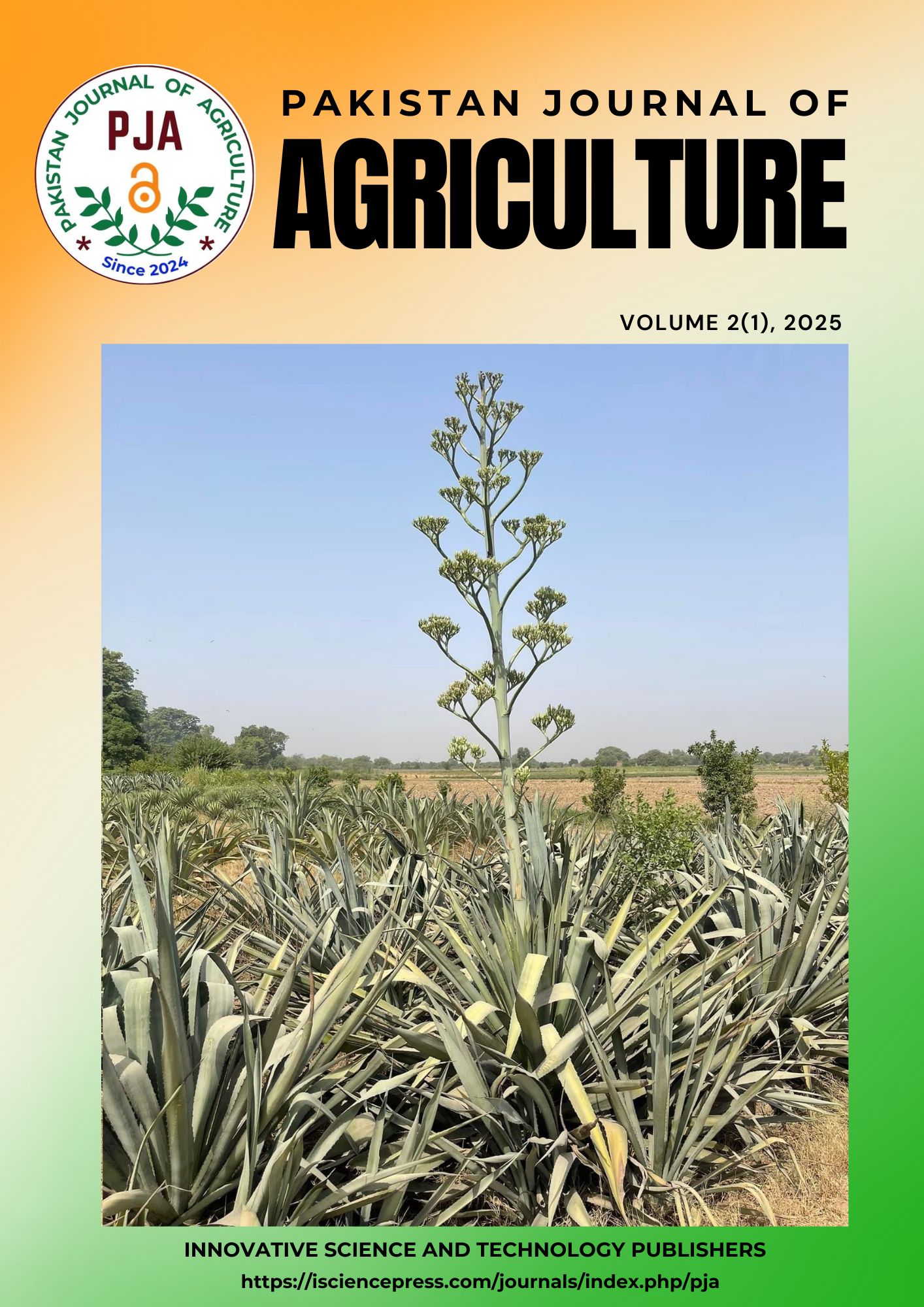Gibberellic Acid (GA3) Enhances biomass production, nitrogen accumulation and crude protein content of Sesbania Aculeata Pers. at Seedling Stage
DOI:
https://doi.org/10.38211/PJA.2025.02.85Keywords:
Sesbania aculeata Pers., Gibberellic Acid, GA3, Plant growth regulators, Foliar sprayAbstract
The use of plant growth regulators has been highlighted as a very essential practice in agriculture. A pot experiment was designed and conducted in a green-house of the Department of Soil Science, Faculty of Crop Production, SAU, Tandojam. The aim of the experiment was to investigate the influence of different concentrations of gibberellic acid (GA3) on the vegetative growth, development and biomass yield of a commercially important plant species locally called Manjhandri (Sesbania aculeata Pers.). The experiment was laid out in a complete randomized design with three replications. The seed was purchased from the market and sown in the pots by placing ½ inch deep in soil. After one week the seedlings were thinned to allow single plant per pot. The crop was irrigated with canal water and fertilized with chemical macronutrient fertilizer (ENGRO-NPK) based on their specific growth requirement. Thirty-days after planting the seedlings were sprayed with GA3 solutions: The GA3 concentrations included in the study for spray were: G0 = Control (without GA3 application), G1 = 40 mg L-1, G2 = 60 mg L-1, G3 = 80 mg L-1, G4 = 100 mg L-1 and G5 = 120 mg L-1 (in G5 treatment, seedlings could not survive, hence this treatment was excluded from the study). The data were recorded for plant height, number of composite leaves (plant-1), shoot and root fresh and dry weights and stem girth (mm). The results obtained from the study revealed that almost all the recorded growth and development traits of Sesbania aculeata Pers. were significantly affected by GA3. The seedlings sprayed with 40, 60, 80 and 100 mg L-1 GA3 showed 10, 31, 44 and 63% increase in height; 22, 35, 58 and 81% increase in number of composite leaves (plant-1); 33, 59, 83 and 148% increase in shoot fresh weight; 15, 27, 49 and 90% increase in root fresh weight; 45, 73, 98 and 169% increase in shoot dry weight; 18, 34, 52 and 75% increase in root dry weight; 14, 28, 38 and 62% increase in stem girth and 32, 38, 70 and 81% increase in nitrogen and crude protein over unsprayed (control) seedlings, respectively. The results advocate that the application of GA3 (100 mg L-1) at seedlings stage improves growth and development of Sesbania aculeata. Hence, GA3 can be used to spray this industrially important plant species.
References
Chang YS, Sung FH. 2000. Effects of gibberellic acid and dormancy-breaking chemicals on flower development of Rhododendron pulchrum. Scientia Horticulturae 83(3):331-337. DOI: https://doi.org/10.1016/S0304-4238(99)00111-9
Chopra SL, Kanwar TS. 1959. Bouyoucos hydrometer method. Analytical Agricultural Chemistry 2:12, 48.
Estefan G, Sommer R, Ryan. 2013. Methods of soil, plant and water analysis: A manual for the West Asia and North Africa Region. ICARDA 3rd Ed. pp. 230.
Fatima A, Umbreen S, Sadia S, Waheed M, Arshad F, Malik MR, Abd_Allah EF. 2024. Mitigation of salinity-induced adverse effects through exogenous application of gibberellic acid in turnip (Brassica rapa L.). Cogent Food & Agriculture 10(1), 2392042. DOI: https://doi.org/10.1080/23311932.2024.2392042
Gupta S, Maurya D, Kashyap S. 2023. Effective Administration of Plant Growth Regulators in Horticultural Crops: A Review. International Journal of Plant & Soil Science 35(11), 36-46. DOI: https://doi.org/10.9734/ijpss/2023/v35i112943
Jackson M. 1958. Soil chemical analysis prentice Hall. Inc., Englewood Cliffs, New Jersey 498(1958), 183-204.
Kandil AA, Sharief AE, Abido WAE, Awed AM. 2014. Effect of gibberellic acid on germination behavior of sugar beet cultivars under salt stress conditions of Egypt. Sugar Technology 16(2):211-221. DOI: https://doi.org/10.1007/s12355-013-0252-7
Monteiro KA, Gonçalves GS, Bazalha CEO, Paula JCB, Guariz HR, Shimizu GD, Faria RT. 2024. Improving flowering and vegetative growth in Oncidium baueri Lindl. through gibberellic acid application: insights into physiological parameters. Ornamental Horticulture 30, e242783. DOI: https://doi.org/10.1590/2447-536x.v30.e242783
Pahi B, Rout CK, Saxena D. 2020. Effects of gibberellic acid (GA3) on quality and yield in grapes. International Journal of Chemical Studies 8(6), 2362-2367. DOI: https://doi.org/10.22271/chemi.2020.v8.i6ah.11126
Preston RL. 2018. Feed composition tables: How to use the 2017 data to mix the best feed for your cattle? www.beefmagazine.com [Accessed on 18/12/2024].
Rowell DL. 1994. The preparation of saturation extracts and the analysis of soil salinity and sodicity. Soil Science Methods and Applications Ed. D. L. Rowell. Longman Group, UK.
Saeed T, Hassan I, Abbasi NA, Jilani G. 2014. Effect of gibberellic acid on the vase life and oxidative activities in senescing cut gladiolus flowers. Journal of plant growth regulation 72(1): 89-95. DOI: https://doi.org/10.1007/s10725-013-9839-y
Shah SMH, Kumar R, Bakshi P, Bhat DJ, Sinha BK, Sharma M, Sharma R. 2023. Influence of Gibberellic Acid on Fruit Crops: A Review. International Journal of Environment and Climate Change 13(8), 1681-1688. DOI: https://doi.org/10.9734/ijecc/2023/v13i82120
Soltanpour PN, Schwab AP. 1977. A new test for simultaneous extraction of macro and micro-nutrients in alkaline soil. Communications in Soil Science and Plant Analysis 8:195-207. DOI: https://doi.org/10.1080/00103627709366714
Sumanasiri H, Krishnarajah SA, Eeswara JP. 2013. Effect of gibberellic acid on growth and flowering of Henckeliahum boldtianus Gardner (Ceylon Rock Primrose). Scientia Horticulturae 159:29-32. DOI: https://doi.org/10.1016/j.scienta.2013.04.021
Thapa Umesh, Ansari Zuby, Ramesh Srinivasan, Krishnaveni Anbalagan, Rabi Ayesha. 2024. Plant Hormones and Growth Regulators: Mechanisms, Interactions, and Agricultural Applications. Agriculture Archives 3. 11-20. 10.51470/AGRI.2024.3.3.11. DOI: https://doi.org/10.51470/AGRI.2024.3.3.11
Uddin ASMM, Gomasta J, Islam MT, Islam M, Kayesh E, Karim MR. 2024. Gibberellic acid spray modulates fruiting, yield, quality, and shelf life of Rambutan (Nephelium lappaceum L.). Journal of Horticultural Research 32(1). DOI: https://doi.org/10.2478/johr-2024-0004
Wu X, Gong D, Zhao K, Chen D, Dong Y, Gao Y, Hao GF. 2024. Research and development trends in plant growth regulators. Advanced Agrochem 3(1), 99-106. DOI: https://doi.org/10.1016/j.aac.2023.11.005
Downloads
Published
How to Cite
Issue
Section
License
Copyright (c) 2025 Zoia Laghari, Nizamuddin Depar, Aziz Laghari, Kanwal Ali Jamali, Fozia Naz Memon, Rawal Odhano

This work is licensed under a Creative Commons Attribution 4.0 International License.



